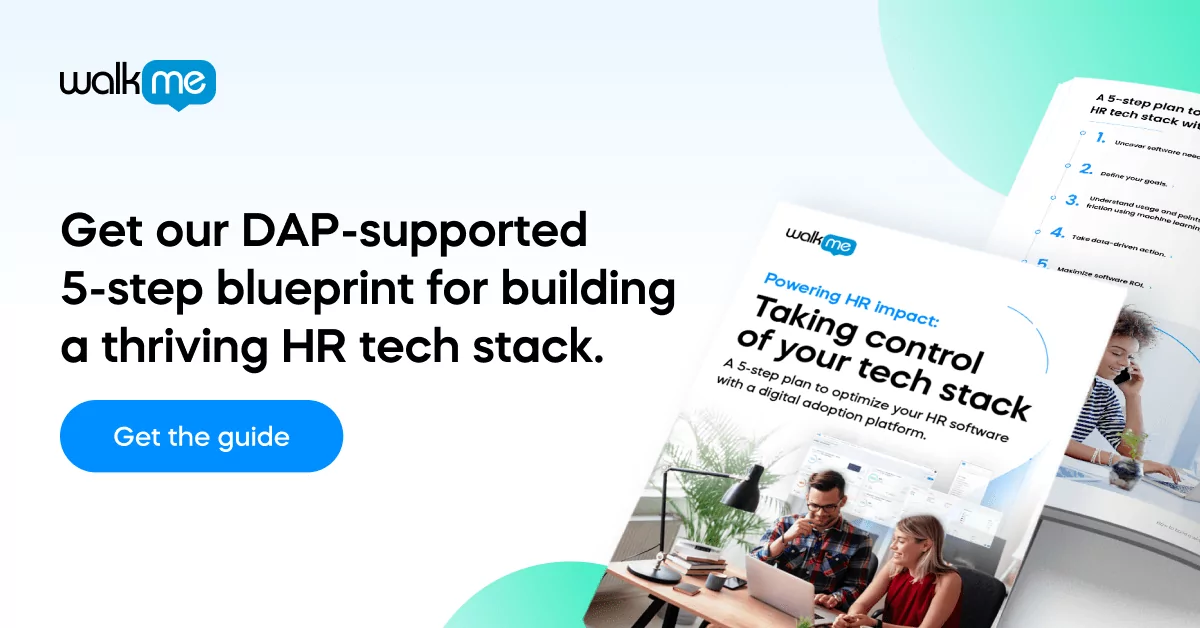In 2023, no business department can afford to be unaccountable. Every area across the company has to pull its weight. And no one can afford to be complacent in their spending. Every business unit should end the year with a good ROI on every investment that you’ve made.
But when figuring out your HR ROI, we have good and bad news.
The bad news is? It’s tough. And in many cases, it’s hard to see how HR investments produce clear value. The good news is – there are many ways to think about the value of HR for your company. And in this article, we’ll talk about how you can do that.
ROI in HR. It’s a simple concept with some wide-ranging implications, so we will start by looking at the meaning of the term. Then, we’ll explain why it’s so important and the challenges of evaluating human capital ROI. We will take you through some steps you need to take to measure your human capital ROI.
Finally, we will suggest a few ways to improve the return on investment from HR activities, whether training and development, recruitment, or anything else.
Calculating Human Capital ROI is not an easy exercise. But in 2023, more and more tools will be available to establish benchmarks, measure performance, and report on outcomes. For example, In 2021, Forrester released a calculator to measure the impact of mental health programs on ROI.
Even though this is a difficult area, we will help you understand how your human capital ROI works.
What is HR ROI?
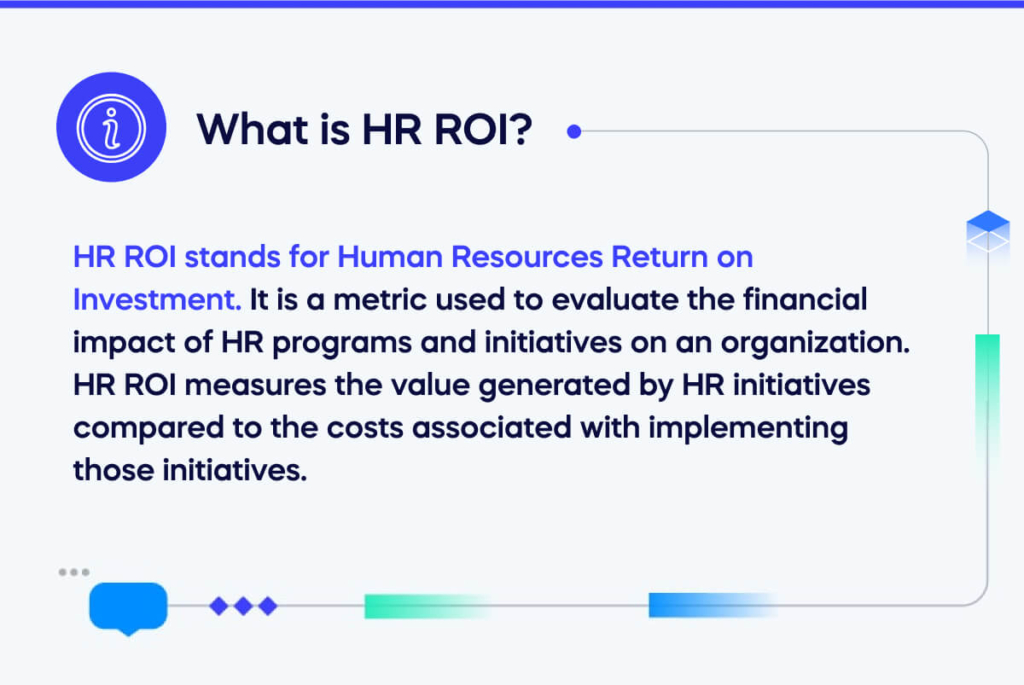
HR ROI stands for Human Resources Return on Investment. It is a metric used to evaluate the financial impact of HR programs and initiatives on an organization. HR ROI measures the value generated by HR initiatives compared to the costs associated with implementing those initiatives.
Often, writers are talking Human Resources ROI with the phrase human capital ROI. In this article, we will use both terms interchangeably.
Measuring the return on investments in HR extends to many different activities. Human capital generally refers to the skills, knowledge, and capabilities of individuals within an organization – especially those that can be turned into profit-making activities. The term may also include social, cultural, and economic capital, although these forms are less likely to be included in a business’s revenue output.
Some aspects of human resources are relatively easy to quantify into an economic ROI. For example, the cost of a sales team’s salaries can be balanced against the income they bring in.
However, other aspects of HR ROI are notoriously difficult to calculate. For example, there’s no doubt that an IT department is fundamental to smooth business operations. But the link between IT human resources and business outcomes is far less clear.
The Importance of HR ROI and Impact
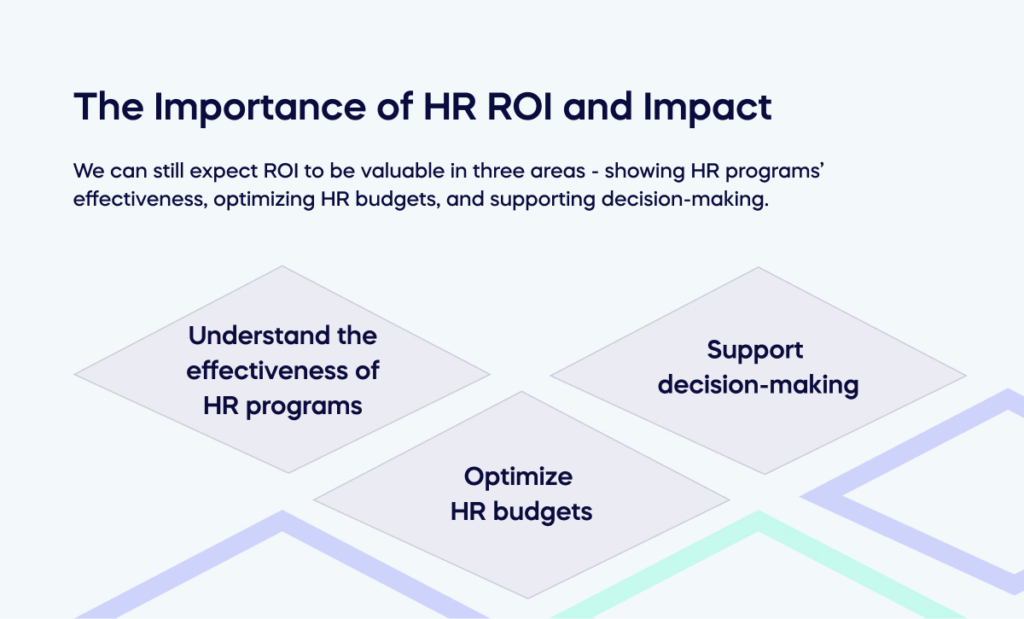
A financial ROI is only one aspect of HR’s positive impact.
HR interventions might help to decrease absenteeism, improve staff retention, increase diversity in the recruitment process, and many other activities. No one questions the importance of these actions. But they cannot easily be mapped onto financial benefits.
However, we can still expect ROI to be valuable in three areas – showing HR programs’ effectiveness, optimizing HR budgets, and supporting decision-making.
- Understand the effectiveness of HR programs: By calculating HR ROI (Return on Investment), organizations can assess the effectiveness of their HR programs and initiatives. HR initiatives, such as training programs, recruitment, or employee engagement, are implemented to improve the organization’s human capital and drive business performance. The ROI calculation enables HR leaders to evaluate whether these programs are generating the desired results and providing a positive return on investment.
- Optimize HR budgets. HR ROI provides insights into the financial impact of HR initiatives and programs, which helps optimize the HR budget. HR leaders can use this information to prioritize investments in areas that yield the highest ROI and cut back on programs that are not delivering the expected results.
- Support decision-making. HR ROI helps support decision-making by providing objective and data-driven information to HR leaders. The ROI calculation can inform decisions about continuing, modifying, or discontinuing HR initiatives. It also provides valuable information for making investment decisions by demonstrating the financial impact of HR programs and initiatives.
The ROI can be especially useful in specific initiatives and transformation projects. This figure can help you prove whether or not the investment was worth it.
The Challenges of Calculating HR ROI
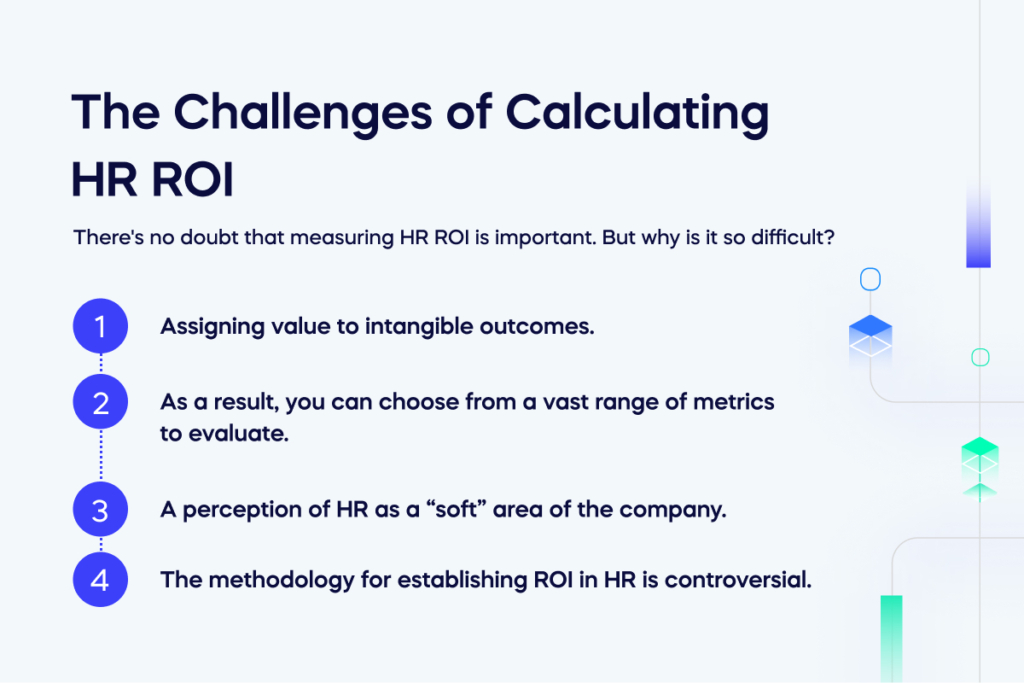
So there’s no doubt that measuring HR ROI is important. But why is it so difficult?
The two main challenges are assigning value to intangible outcomes and the sheer range of metrics from which business leaders can choose when evaluating HR ROI. In addition, there is a tendency for business leaders to perceive HR as a “soft” area of the company, making it difficult to quantify its returns. Finally, there is also controversy surrounding the methodology.
This section will explore these challenges in greater detail and discuss potential solutions for overcoming them. By understanding the obstacles to measuring HR ROI, business leaders can make more effective decisions when assessing their HR interventions.
- Assigning value to intangible outcomes. HR initiatives can impact intangible outcomes such as employee engagement, retention, and job satisfaction, which are challenging to assign a financial value. These outcomes are critical for the organization’s success, but the lack of a clear monetary value can make it difficult to calculate HR ROI accurately.
- As a result, you can choose from a vast range of metrics to evaluate. For example, the Human Capital Metrics Handbook lists over 600 possibilities. Building up your own bank of KPIs and metrics will be essential.
- A perception of HR as a “soft” area of the company. Leaders may not realize that they can measure HR investments in quantifiable terms. And more importantly, the staff responsible for human capital may be resistant to measuring their outcomes. There is a risk that HR will end up being unaccountable.
- The methodology for establishing ROI in HR is controversial. Jac Fitz-enz’s pioneering book The ROI of Human Capital (2000) argues that no one in two hundred years of organizational theory has tried to understand the topic. More recently, a CIPD report suggests that attempts to figure out HR ROI have met with “only limited success.” Today, you can find plenty of material for understanding
How to Calculate ROI on HR Investments
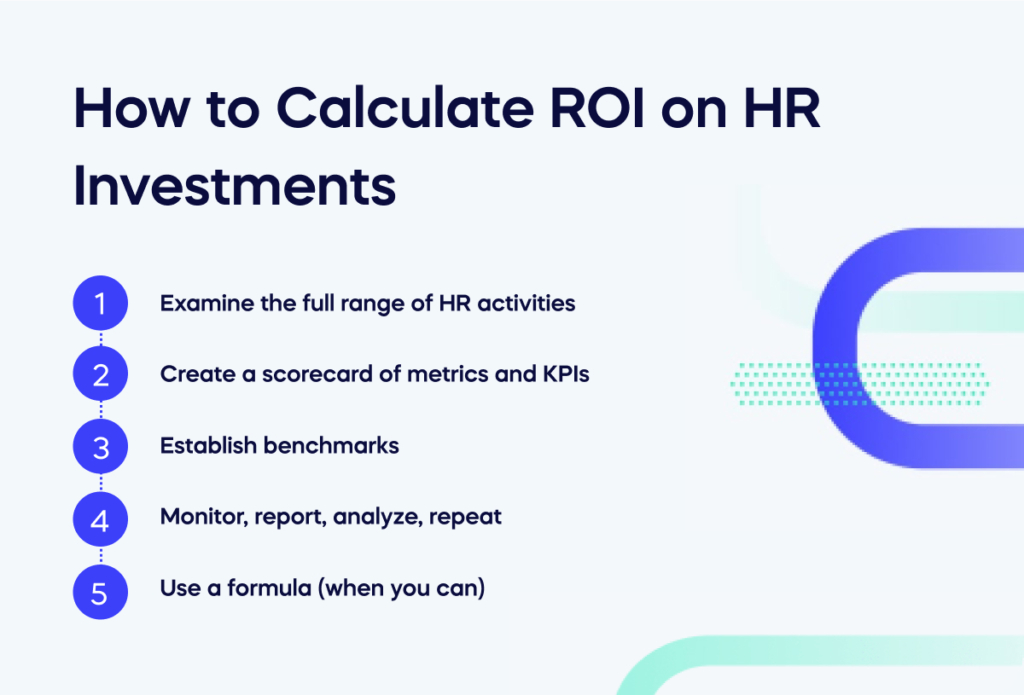
It’s complicated, but finding a way to calculate ROI on HR investments. is important
Doing so will help you better understand the impact of investments, make decisions based on facts, and maximize returns. To calculate ROI, there are a few steps you should take: look at everything that’s happening in HR; create a scorecard of metrics and KPIs; establish benchmarks; monitor progress over time; and, wherever possible, use a formula to quantify the results.
In this section, we’ll go through these steps one by one.
Examine the full range of HR activities
A report from the CIPD established five areas where HR could make an impact:
- spending on human capital
- ability to retain talent
- leadership depth
- leadership quality
- employee engagement.
It is tempting to ignore qualitative measures. But the fact is, even a cold hard assessment of financial return needs to take everything into account.
Create a scorecard of metrics and KPIs
As previously mentioned, there are various metrics that organizations can use to assess the impact and ROI of their HR initiatives. Due to the numerous variables in HR performance, it’s crucial to conduct a comprehensive analysis instead of relying on a single figure.
Using a scorecard can help measure the impact of HR programs and initiatives at different company levels. This approach enables the organization to evaluate the success of HR initiatives from rank-and-file staff members to middle management and C-suite executives, each with unique performance indicators.
Establish benchmarks
Benchmarks are essential for establishing the ROI of HR investments because they provide a reference point for comparison. Benchmarks enable organizations to compare their HR initiatives’ performance with industry standards or best practices. By establishing benchmarks, organizations can determine whether their HR investments generate a positive return on investment or whether there is room for improvement.
Additionally, benchmarks help organizations set realistic goals for their HR initiatives. BOrganizationscan set achievable targets for their HR programs. by understanding industry standards and best practices. These goals can then be used to measure the success of HR initiatives and evaluate their impact on business outcomes.
Monitor, report, analyze, repeat
In today’s world, many HR investment challenges can be solved using data. You can monitor, discover, evaluate, and report on a wide range of business activities based on your chosen KPIs.
A recent McKinsey article explains how people analytics has become an unexpectedly powerful tool.
A DAP will be a good investment for some HR investments – showing how people work, where they work, and whether your expenditure is proving worthwhile.
Use a formula (when you can)
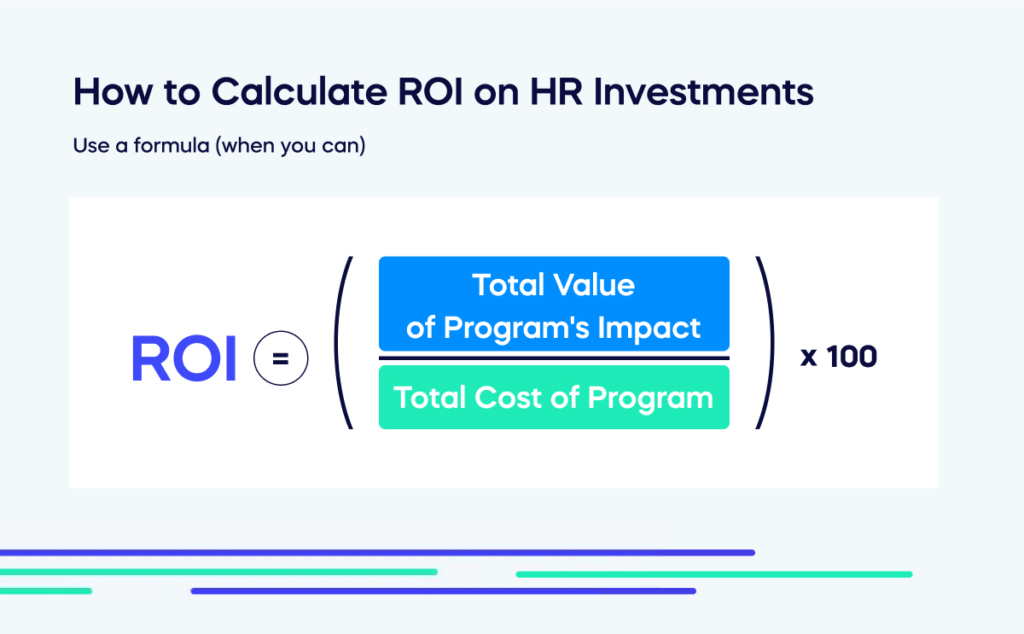
For a specific program, divide the total value of the program’s impact by the total cost of the program and multiply by 100. The usual formula is:
ROI = (Total Value of Program’s Impact / Total Cost of Program) x 100
JRememberthat this will only work when you can establish a clear cause between an intervention and its outcomes.
How to improve HR ROI in your organization
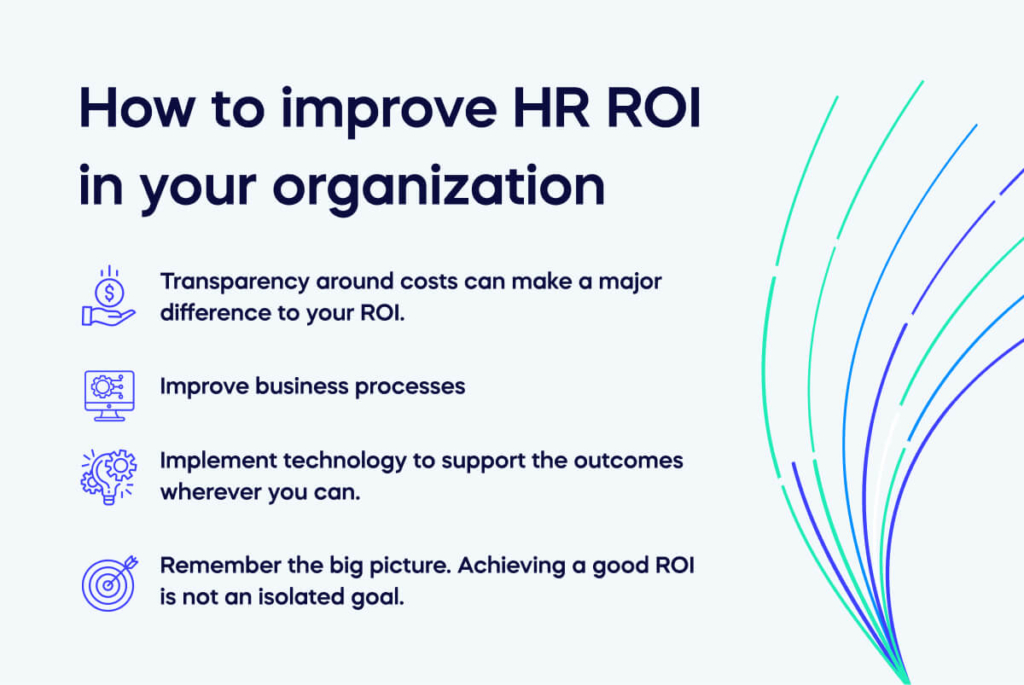
You will often discover that your ROI isn’t where you’d like it to be. Don’t worry – there are many strategies you can use to start addressing the ROI in human capital decisions.
Whether you are looking to improve your financial position, boost employee morale and retention or take a more strategic approach to human resource management, here are some ways to improve ROI in your organization.
- Transparency around costs can make a major difference to your ROI. Do people know the financial cost of calling a meeting? Or, what’s the price of adding another five people to the candidate shortlist for an interview? When staff understand the impact of their decisions, they are far more likely to be sensible and conservative.
- Improve business processes: Are you truly efficient, or is there room for improvement? Undertake a business process analysis to identify areas where process improvements can be made. This could include automating processes, streamlining tasks, and using technology for more efficiency. The goal is to ensure that employees can do their jobs more effectively and efficiently, ultimately leading to greater ROI for the company.
- Implement technology to support the outcomes wherever you can. Technology can drastically increase operational efficiency and reduce manual effort, speeding up processes and reducing costs. Investing in HR technology solutions can help you rapidly measure the ROI of your human capital investments. Whether it’s a system for tracking hours worked or time off requests, a web-based recruitment system, or software to track performance and goals, technology can be a huge asset in helping you maximize the ROI of your human capital.
- Remember the big picture. Achieving a good ROI is not an isolated goal. It is only achievable as part of an organization-wide HR strategy. The ROI is important because it affects your bottom line – but the true impact is much wider. You need to consider the overall effect of your HR decisions and investments on productivity, morale, retention, and other non-financial metrics. When viewed from this angle, it can become much clearer how even seemingly small decisions about employees can drastically affect ROI.
HR ROI: What’s Next?
In a 2023 Forbes article, the writer Eric Mosley declared this year “the year of ROI”. For Mosley, HR data has a vital role. He is optimistic for companies who invest effectively in digital transformation projects: “There is no hiding from data, and if you know how to use it, you’ll make better investments in people and programs.”
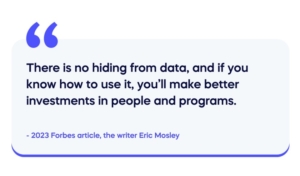
With a recession getting underway, it’s vital for leaders in all parts of a business to make the best decisions. With data on your side, this is completely possible.
The ROI on human capital investments is one tool that can help you ensure your decisions yield the best possible return. By tracking and measuring ROI, you can make the best possible decisions regarding human capital investments.
This means having transparency around costs, improving business processes, and investing in technology to support the outcomes – all while keeping an eye on the big picture of how your HR decisions affect productivity and morale.
